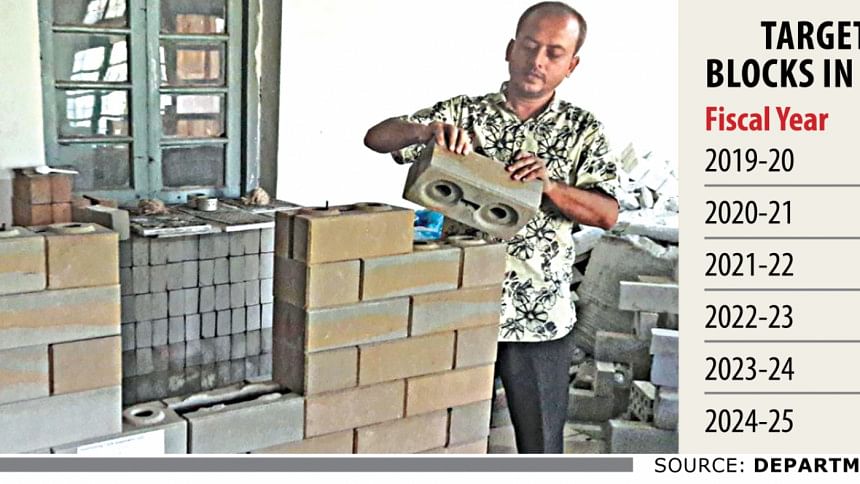Eco-friendly blocks made mandatory in govt projects

The government has made mandatory the use of blocks in public construction from this fiscal year as it moves to cut the reliance on bricks for building structures, walls and roads, an official document showed.
Under the plan, state-run agencies will use blocks, which will be made up of sand, cement fly ash or materials other than clay, to build and repair walls of buildings, surrounding walls, herringbone bond road, and rural passages in place of bricks, which use valuable topsoil as raw material.
Agencies will have to use 10 percent blocks in the current fiscal year of 2019-20 and 20 percent the following year, according to a notification of the environment, forest and climate change ministry, issued on November 24.
“Fire-burnt bricks pollute air and the environment. It also affects agricultural lands. This is why we want to move to blocks from bricks,” said Mallick Anwar Hossain, additional director general of the Department of Environment.
“We have decided to completely shift to blocks from fire bricks by 2025.”
The ministry directed to fix the target of using 20 percent blocks in building and other constructions in fiscal 2020-21 and 30 percent the following year. It has set a target to use 60 percent blocks in 2022-2023 and 100 percent in 2024-2025, the year when the country is expected to phase out bricks.
The directive will not be applicable to the construction and repairing of base and sub-base of highways.
The move comes amid concerns of environmental pollution from brick kilns, which are producing clay bricks and burning them to meet soaring demand from the construction sector.
Brick kilns were identified as the single largest source of air pollution in Dhaka city, with 50 percent of the total pollution attributed to them.
The actual number of brick kilns in Bangladesh and the bricks they produce is hard to come by. The number of kilns will be between 7,000 and 10,000, producing 2,100 crore to 4,300 crore pieces of bricks annually, according to trade bodies representing brick makers.
Hossain said many countries produce bricks from blocks instead of burning them. But fire-burnt bricks are used in Bangladesh as well as in the subcontinent.
The public construction accounts for more than 30 percent of the total construction in Bangladesh, while the rest is carried out by the private sector.
The DoE senior official said the use of blocks has been made compulsory for public construction with the objective of encouraging the private sector to follow suit.
“When we involve the government in doing so, we can ask industrialists and others to follow it. How can I ask others to do the job before I do this?” he said.
Blocks are made locally but marketing remains a major barrier to its expanded use, Hossain said. “Production will increase once demand rises.”
“We have enough support to do this locally and demand could be met. We believe many brick-kiln owners will shift to making blocks, as we will eliminate traditional or zigzag type kilns,” he said.
Hossain also said the use of blocks would not push the construction cost up. Rather, the construction cost will come down to a large extent as blocks will be made from sand without affecting natural resources.
The cost of producing blocks will be Tk 1 less than Tk 8-8.5 needed to make a piece of brick, he said, citing an estimate.
“If environmental and production costs are estimated, the cost of blocks would be much less in case of blocks.”
Mizanur Rahman Babul, president of the Bangladesh Brick Manufacturing Owners’ Association, said brick kiln owners would not be affected if the government gradually moves to blocks.
Demand for blocks will be created in the private sector after the government starts using the material and many brick-field operators will switch to making blocks, he said.
BN Dulal, secretary general of the Bangladesh Auto Brick Manufacturers Association, echoed Babul. SM Khorshed Alam, president of the Bangladesh Association of Construction Industry, said the use of block is crucial to saving the environment.
“But blocks should be made easily available. The quality of blocks should also be up to the mark.”

 For all latest news, follow The Daily Star's Google News channel.
For all latest news, follow The Daily Star's Google News channel. 



Comments